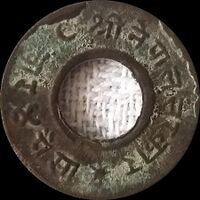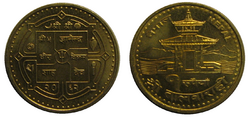Nepalese rupee
Topic: Finance
 From HandWiki - Reading time: 5 min
From HandWiki - Reading time: 5 min
| रुपैयाँ (Nepali) | |
|---|---|
| ISO 4217 | |
| Code | NPR (numeric: 524) |
| Subunit | 0.01 |
| Unit | |
| Symbol | रु |
| Denominations | |
| Subunit | |
| 1⁄100 | Paisa |
| Banknotes | |
| Freq. used | रु5, रु10, रु20, रु50, रु100, रु500, रु1000 |
| Rarely used | रु1, रु2, रु25, रु250 |
| Coins | |
| Freq. used | रु1, रु2 |
| Rarely used | 1, 5, 10, 25, 50 paisa, रु5, रु10 |
| Demographics | |
| Date of introduction | 1932 |
| User(s) | Template:Country data Kingdom of Nepal (1932–2008) Template:Country data Federal Democratic Republic of Nepal (2008–present) |
| Issuance | |
| Central bank | Nepal Rastra Bank |
| Website | www |
| Valuation | |
| Inflation | 3.6% (2021) |
| Source | Statista |
| Pegged with | ₹1 = रु1.60 (buy) ₹1 = रु1.6015 (sell) |
The Nepali rupee (Nepali: रुपैयाँ; symbol: रु॰; code: NPR) is the official currency of the Federal Democratic Republic of Nepal. The Nepali rupee is subdivided into 100 paisa. The issuance of the currency is controlled by the Nepal Rastra Bank, the central bank of Nepal. The Nepali rupee was introduced in 1932 when it replaced the Nepalese mohar at the rate 2:1.[citation needed]
The Nepali rupee (रु) has been pegged to the Indian rupee (₹) at the rate रु1.60 = ₹1 since 1994; prior to this, it had been pegged at the rate रु1.45 = ₹1.[2]
History
The rupee was introduced in 1932, replacing the silver mohar at a rate of 2 mohar = 1 rupee. At first, the rupee was called the Mohru in Nepali.[3]
The "Bullet paisa"
In 1955, 4 Paisa coins were minted, made from rifle cartridge cases from World War II that were used by the Gurkha soldiers who fought against the Imperial Japanese in the Pacific. The coins were produced by removing the primer from the cases and the cases were then converted into the 4 Paisa coins to commemorate their courage and victory during the war.
Due to the small number of cases found, these coins were minted for one year only.[citation needed]
They are known as the "Nepal Bullet Paisa".[4][5]
1972–2007
During King Birendra’s rule, one can also distinguish between two major series of banknotes. The first series features the king wearing the military uniform while on the notes of the second series the king is wearing the traditional Nepalese crown adorned with feathers of the bird of paradise. During this period regular banknotes of 2 and 20 rupees and special banknotes of 25 and 250 rupees were issued for the first time. The legends found on the last issues of Gyanendra revert to Nepal sarkar ("Nepalese government"), thus omitting the reference to the king.
2007–Present
In October 2007, a 500-rupee note was issued on which the king's portrait was replaced by Mount Everest. This reflects the historic change from a kingdom to a republic which took place in May 2008 in Nepal. Further notes of 5, 10, 20, 50, 100 and 1000 rupees with Mount Everest and without reference to the king in their legends followed in 2008. The first issues of the 500- and 1000-rupee notes were printed on paper which still had the king's crowned portrait as a watermark in the "window" on the right part of the face of the notes. It was decided to print a red Rhododendron flower (Nepal's national flower) on top of the watermark. Notes of these denominations which were issued in 2009 and thereafter are printed on paper which has a Rhododendron flower as watermark instead of the royal portrait and were therefore released without the additional overprint in red.
Banknotes
On 17 September 1945, the government introduced banknotes for 5, 10 and 100 rupees, with the name mohru used in Nepalese.[6] There are also 250-rupee notes commemorating the Silver Jubilee of Birendra Bir Bikram Shah in 1997.[citation needed][7] Since 2007, Nepalese rupee banknotes have been produced by Perum Peruri, the mint company of Indonesia.[8]
In 2012, Nepal Rastra Bank issued a revised banknote series that is similar to the 2007 series, but now include inscriptions in English and the year of issue on the back.
| Image | Value (rupees) |
Main colours | Description | Date of issue | ||
|---|---|---|---|---|---|---|
| Obverse | Reverse | Obverse | Reverse | |||
| 5 | Lilac and pink | Mount Everest; temple of Taleju; obverse of coin | Two yaks grazing; Mount Everest | 2012 | ||
| Mount Everest; Kasthamandap Temple | Yak | 2017 | ||||
| 10 | Brown and green | Mount Everest; Garud Narayan of Changu Narayan temple | Three blackbucks grazing; trees; bank logo | 2012 | ||
| Antelope; trees; bank logo | 2017 | |||||
| 20 | Orange and brown | Mount Everest; temple of god Krishna of Patan; Garuda atop pillar | Swamp deer; trees; mountain; bank logo | 2012 | ||
| Sambar deer; trees; mountain; bank logo | 2016 | |||||
| 50 | Purple, green and blue | Mount Everest; Rama-Janaki temple of Janakpur | Male tahr; mountains; bank logo | 2012 | ||
| Snow leopard; bank logo | 2016 | |||||
| 100 | Green and lilac | Mount Everest; Mayadevi inside silver metallic oval; map of Nepal; Ashoka pillar; wood carvings from temple of Taleju in Kathmandu; description "Lumbini – Birthplace of Lord Buddha" |
One-horned rhinoceros in grassy plain; bank logo | 2012 | ||
| One-horned rhinoceros and its offspring in grassy plain; bank logo | 2015 | |||||
| 500 | Brown and violet | Mount Everest; god Indra; Mount Amadablam and Thyangboche monastery; wood carvings; clouds | Two tigers drinking melted snow | 2012 | ||
| Tiger | 2016 | |||||
| 1,000 | Blue and gray | Mount Everest, Swayambhunath Stupa & Harati temple | Asian elephant | 2013 | ||
| Twin Asian Elephants | 2019 | |||||
Exchange rates
Between 1857 and 1930, the Nepalese rupee (two half-rupees or mohars[9]) was fixed at 1.28 per Indian rupee.[3] After this period, its value fluctuated against the Indian rupee, falling to रु1.60 = ₹1 in 1939, rising to रु0.60 = ₹1 during the Second World War and falling again afterwards. In 1952, the government of Nepal officially pegged the Nepalese rupee at रु1.28 = ₹1, although the market rate remained at रु1.60 = ₹1.[3]
Between 1955 and 1957, there was a series of soft peg revaluations that started at रु1.755 = ₹1 and appreciated to रु1.305 = ₹1 by 1957. In 1958, the government applied a new exchange rate of रु1.505 = ₹1 for the purchase of plane tickets only. A hard peg of रु1.60 = ₹1 was instituted in 1960, which was revalued to रु1.0155 = ₹1 when the Indian rupee was sharply devalued on 6 June 1966.[3] The Indian rupee ceased to be legal tender in Nepal in 1966.[3]
From 1967 to 1975, the government pegged the Nepalese rupee against the Indian rupee, the US dollar and gold, starting at रु1.35 = ₹1, रु10.125 = US$1 and रु1 = 0.08777g gold. By the time the gold peg was removed in 1978, the exchange rate was रु1.39075 = ₹1, रु12.50 = $1 and रु1 = 0.0808408g gold.[3]
In 1983, the Nepali rupee's anchor was changed to a trade-weighted basket of currencies, which in practice amounted to a hard peg against the Indian rupee. This remained until 1993, when the peg was officially set at रु1.60 = ₹1.[3]
See also
- Crore
- Economy of Nepal
- Nepalese coins
References
- ↑ "Nepal Rastra Bank". http://nrb.org.np/fxmexchangerate.php?YY=&&MM=&&DD=.
- ↑ "'Nepal to keep currency pegged to Indian rupee' | Business Line". Thehindubusinessline.com. 2018-01-11. http://www.thehindubusinessline.com/money-and-banking/nepal-to-keep-currency-pegged-at-to-indian-rupee/article9689230.ece.
- ↑ 3.0 3.1 3.2 3.3 3.4 3.5 3.6 Schuler, Kurt (2004-02-29). "Tables of Modern Monetary History: Asia". http://users.erols.com/kurrency/asia.htm.
- ↑ "4 Paisa - Tribhuvana Bir Bikram". 18 February 2021. https://en.numista.com/catalogue/pieces15218.html.
- ↑ Collector Club - La casa del collezionismo, I semestre 2021, inserto, pag 6 "La moneta proiettile".
- ↑ Linzmayer, Owen (2012). "Nepal". The Banknote Book. San Francisco, California.
- ↑ "Golden Jubilee Publications-Notes and Coins of Nepal". https://www.nrb.org.np/contents/uploads/2020/12/Golden_Jubilee_Publications-Notes_and_Coins_of_Nepal.pdf.
- ↑ "Archived copy". http://majalah.tempointeraktif.com/id/arsip/2010/05/03/EB/mbm.20100503.EB133448.id.html.
- ↑ Rawat, Pooran Chand (1974). Indo-Nepal Economic Relations. Lawrence Verry Incorporated. p. 130. ISBN 9780842606561.
Sources
- Agrawal (Giriya), Shyam and Gyawali, Kamal Prasad: Notes and Coins of Nepal. Nepal Rastra Bank Golden Jubilee Year 2005–06, Kathmandu, 2006.
- Bertsch, Wolfgang: "The Legends on the Banknotes of Nepal", International Banknote Society (IBNS) Journal, vol. 48, no. 3, 2009, p. 39–44.
- Jha, Hari Jaya: An Overview of Nepalese Paper Money. Manjeeta Jha, Lalitpur (Patan), B.S. 2058 (= A.D. 2001).
- Lorenzoli, Giovanni: "Nepali artistic buildings as seen on Nepali notes". Journal of the International Banknote Society, vol. 43, no. 3 (2004), p. 6–14.
- Shrestha, Ramesh: Nepalese Coins & Bank Notes (1911 to 1955). Kazi Mudhusudan Raj Bhandary, Kathmandu, 2007.
- Wittmann, Hans: Die Banknoten des Königreichs Nepal. Unpublished, Wiesbaden, 2002.
Further reading
- Otto, Heiko. "Historical and Current Banknotes of Nepal". http://www.bis-ans-ende-der-welt.net/Nepal-B-En.htm.
 |
 KSF
KSF




